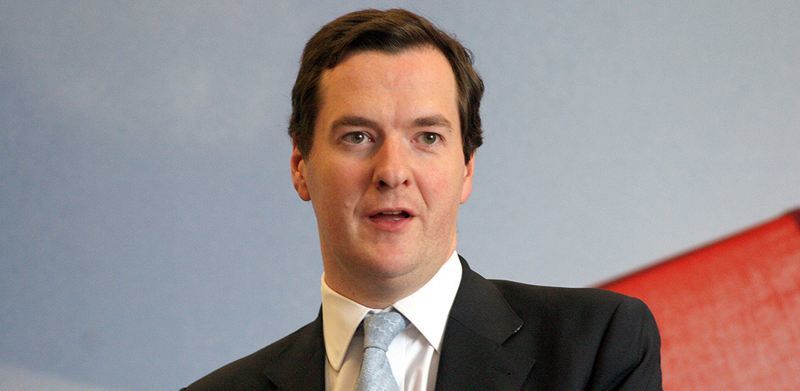Heavy snow before Christmas has been blamed for leaving the UK economy teetering on the brink of recession once again.
According to provisional figures from the Office for National Statistics yesterday, gross domestic product (GDP) in the UK unexpectedly shrank 0.5% between October and December.
Economists forecast growth of 0.2% and 0.6%. Instead, the economy has contracted for the first time since the third quarter of 2009, renewing fears of a double-dip recession.
However, Chancellor George Osborne said the government’s spending plans will not be “blown off course” because of the poor performance.
Labour maintains the UK government’s £81 billion spending cuts have been made too fast and are jeopardising the economic recovery.
“These are obviously disappointing numbers, but the ONS has made it very clear that the fall in GDP was driven by the terrible weather in December,” said Mr Osborne.
He added, “It’s notable that sectors of the economy that are less affected by the poor weather, such as manufacturing, continue to perform strongly, helping to rebalance our economy.
“There is no question of changing a fiscal plan that has established international credibility on the back of one very cold month. That would plunge Britain back into a financial crisis.
“We will not be blown off course by bad weather.”StagnantAn ONS spokesman said that, without the weather, GDP in the quarter would have remained stagnant at zero per cent. Recession is defined as two quarters of decline in GDP.
He said, “It’s likely the bad weather contributed to most or all of that fall, but we would be saying GDP was flat without the weather.”
Jonathan Loynes, chief European economist at Capital Economics, said, “Although heavily affected by the weather, the UK’s shockingly-bad fourth quarter GDP figures showing a 0.5% quarterly contraction-raise serious concerns over whether the economy is in a strong enough position to withstand the fiscal tightening.”
Scottish Secretary Michael Moore said, “The cold weather has had a significant knock-on effect in our economy. The government has put a fiscal plan in place to reduce the deficit.
“Today the IMF has again said the failure to implement credible fiscal consolidation plans is a risk to growth in advanced economies. That is why we must stay the course on the plan we set out in June.”
Scottish finance minister John Swinney said, “Today’s shock UK figures entirely vindicate the Scottish Government’s decision to defer the UK coalition government’s Emergency Budget cuts for 2010-11 to next year, so that we can continue investing and building recovery now.
“Clearly, Westminster’s cuts go too far and too fast and are choking off the UK’s recovery. The UK coalition government can’t say they weren’t warned the Scottish Government, expert economists and many others have been warning for months about the Treasury risking recovery.
“This is a wake upcall, and the UK government needs to change course. The Scottish Government is building recovery in Scotland, with a construction sector that is outperforming the UK as a whole, and Scotland is the only nation in the UK experiencing rising employment and falling unemployment.”
Scottish Labour leader Iain Gray said, “The UK government’s public sector cuts are too fast and too deep and the VAT rise is hitting consumers in the pocket.”Time for cuts?Graeme Brown, director of Shelter Scotland, said, “In light of the shock contraction in the economy which the Office for National Statistics has blamed partly on stagnation in the construction sector, is now the right time to be cutting investment in building projects as outlined in the draft Scottish budget?”
Grahame Smith, general secretary of the Scottish Trades Union Congress, said, “The recovery has stalled even before it has had to cope with a massive withdrawal of demand through the coalition’s spending cuts.”
A spokesman for the Scottish Chambers of Commerce said, “We are very disappointed in the figures but they were affected by the weather. We are hoping deferred spending will help put us on an even keel and avoid a double-dip recession.”
Last night, Bank of England Governor Mervyn King said it was a stark reminder recovery will be “choppy.”
In a speech in Newcastle, he warned Britons to expect inflation to rise to 4-5% over the next few months.
Real wages will plunge back to 2005 levels as prices soar and cuts take effect, although he says the economy is well-placed to return to growth.
However, Mr King sees inflation as the biggest immediate headache.
Fellow Monetary Policy Committee member Andrew Sentance who has repeatedly voted for a quarter point interest rate rise to ease inflation said last night the “time has come to act” as he cautioned price pressures were not one-off.
With the economy veering close to stagflation, the bank is hampered in its ability to address either growth or inflation without making the other worse.
Photo used under Creative Commons licence courtesy of Flickr user altogetherfool.
